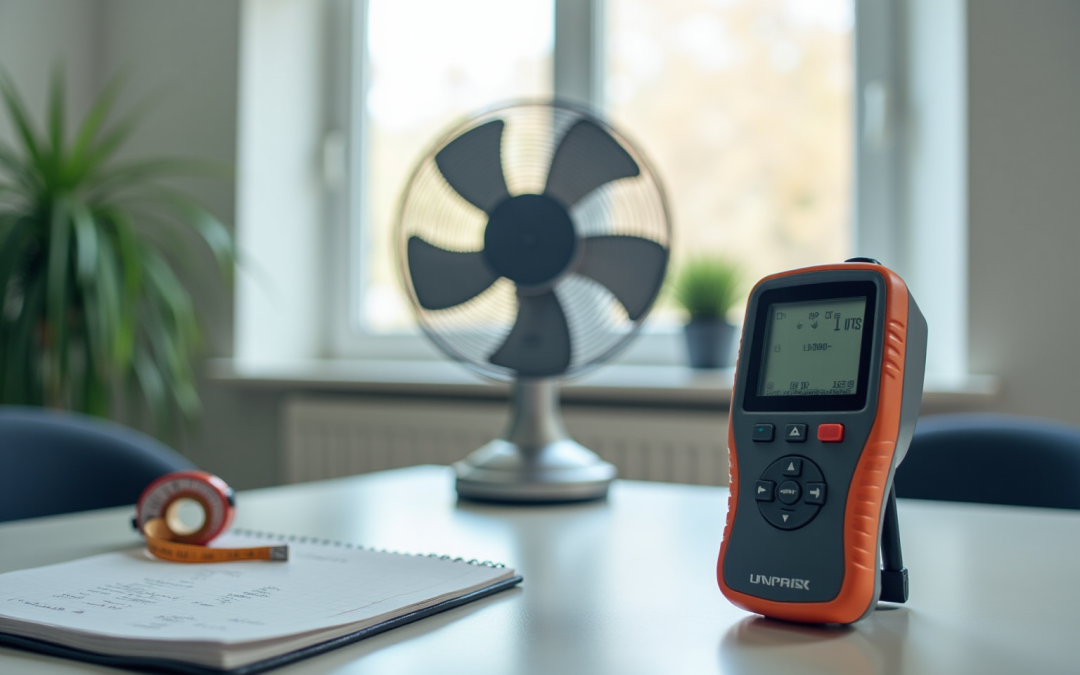Overview
This article serves as a comprehensive guide for measuring the decibel levels produced by fans, outlining the essential tools and step-by-step procedures required for accurate sound level assessment. It underscores the significance of maintaining consistent measurement conditions while also addressing common challenges that may arise. By doing so, it empowers readers to effectively evaluate fan noise levels, thereby protecting hearing and enhancing workplace environments.
Introduction
Understanding the noise levels produced by fans is essential for creating comfortable living and working environments. Yet, many individuals remain unaware of how to measure this sound intensity accurately. By delving into the decibel scale and the factors that influence fan noise, readers can gain valuable insights into the performance of their appliances. However, various measurement challenges and potential inaccuracies can complicate this process.
So, how can one ensure reliable results when assessing the true decibel output of a fan? This guide provides a step-by-step approach to mastering fan decibel measurement, equipping readers with the knowledge necessary to navigate this often-overlooked aspect of home and workplace acoustics.
Understand Decibel Measurement Basics
Understanding fan noise levels involves measuring sound intensity in decibels (dB), which raises the question of how many decibels is a fan. It is essential to recognize that a 10 dB increase indicates a tenfold rise in sound intensity. Joy Victory articulates this concept succinctly: “Every increase of 10 dB on the decibel scale is equal to a 10-fold increase in sound pressure level.” For perspective, normal conversation typically registers around 60 dB, while a whisper is approximately 30 dB. Familiarity with these benchmarks facilitates effective interpretation of your measurements.
Moreover, it is important to acknowledge that fan sounds can fluctuate based on various factors, including speed, design, and environmental conditions. For instance, household fans can produce sound intensities that raise the question of how many decibels is a fan, ranging from 30 dB for quieter models to over 60 dB for high-speed settings. Additionally, at 2 watts, the output reaches 89 dB, underscoring the relationship between power ratings and sound output. Consequently, measuring under consistent circumstances is crucial for achieving accurate results. Furthermore, understanding that sound pressure level (SPL) diminishes by -6 dB when the distance doubles is vital for evaluating fan sound across different applications.
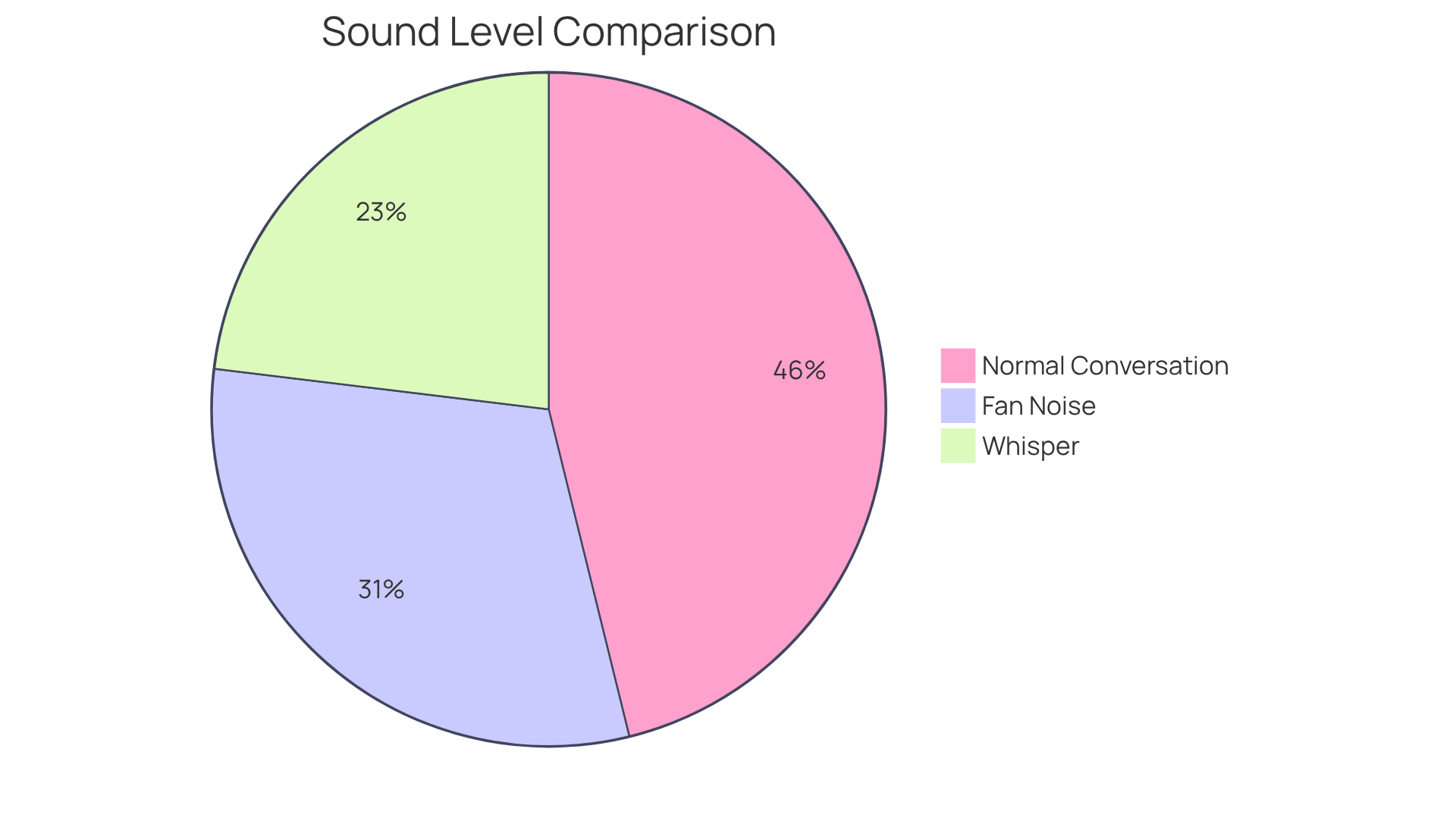
Gather Necessary Tools for Measurement
To accurately measure a fan’s decibel level, it is essential to utilize the following tools:
- Sound Level Meter: This device is critical for measuring sound intensity in decibels (dB). Ensure it has a measuring range suitable for the anticipated noise levels of your fan, ideally between 40 to 130 dB, to accurately determine how many decibels is a fan, with an accuracy of ±2 dB to guarantee dependable readings.
- Tripod or Stand: A stable platform for the sound level meter is vital. Positioning it at a consistent height and distance from the fan is necessary for reliable readings.
- Measuring Tape: This tool is used to measure the distance between the fan and the sound intensity meter, with 1 meter being the standard recommendation for accurate assessments.
- Notebook and Pen: It is important to record your metrics and observations meticulously to track changes and ensure data integrity.
- Calibration Instruments: If available, utilize calibration instruments to verify that your sound meter is functioning accurately before conducting assessments. Regular calibration is crucial for maintaining accuracy, as sound level meters can drift over time. Laboratory calibration is typically required annually to ensure compliance with industry standards.
Integrating these tools into your evaluation process will significantly enhance the reliability of your fan noise assessments, particularly in determining how many decibels is a fan, ensuring adherence to industry standards and safeguarding worker hearing. As recommended by NIOSH, limiting 8-hour exposure to less than 85 dBA is essential; therefore, accurate measurements are paramount for protecting health.
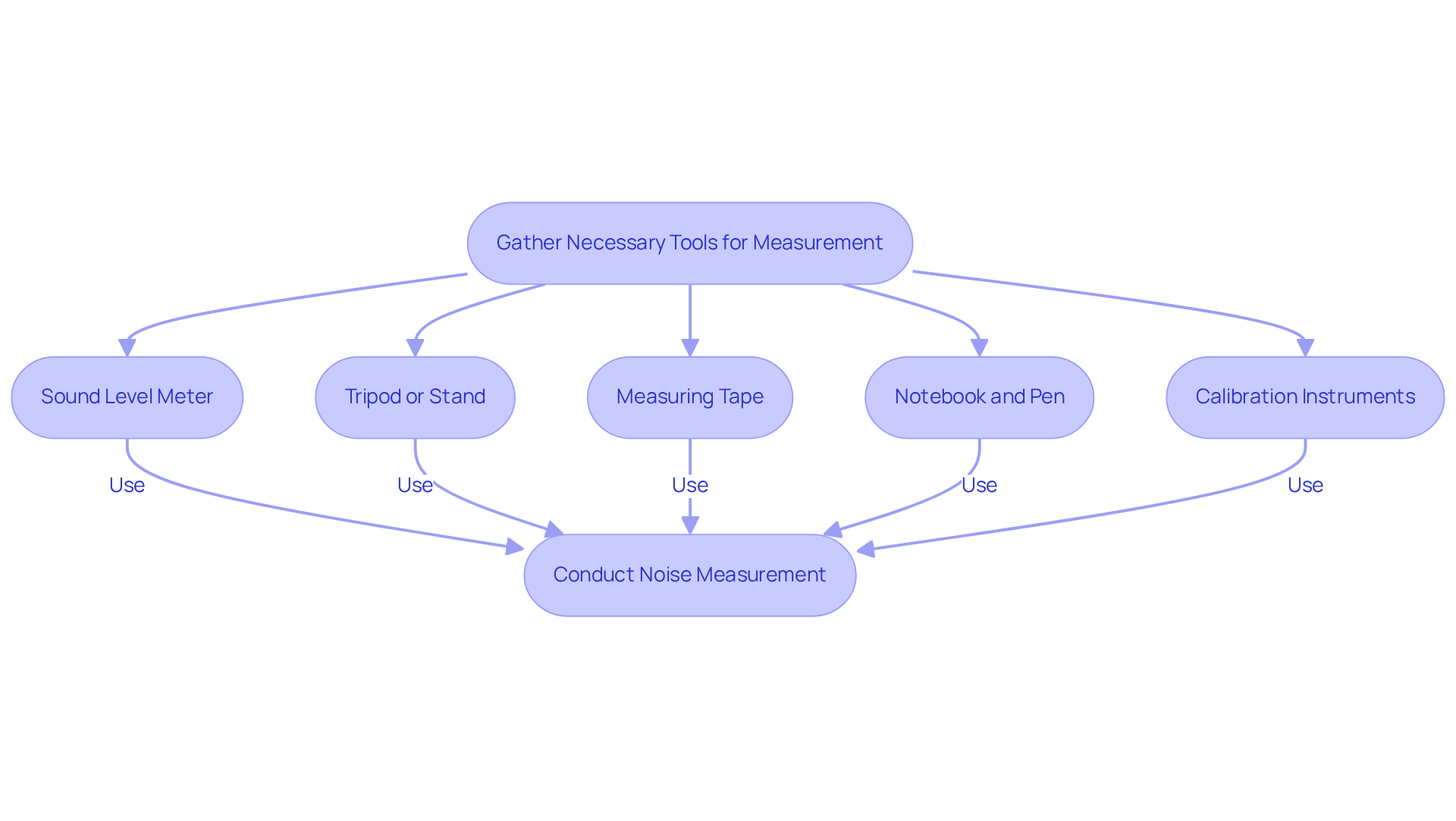
Follow Step-by-Step Measurement Procedures
To accurately measure the decibel level of your fan, follow these steps:
- Set Up the Sound Meter: Position the sound meter on a tripod or stand at a height of approximately 1 meter from the ground, facing the fan.
- Position the Meter: Ensure the meter is placed 1 meter away from the fan, directly aligned with the airflow.
- Turn on the Fan: Activate the fan and allow it to reach its full operating speed.
- Take Measurements: Record the decibel reading shown on the sound meter. It is advisable to take multiple readings—at least three—to ensure consistency and reliability.
- Average the Readings: Compute the mean of your readings to acquire a reliable decibel value for the fan.
- Document Conditions: Note the fan speed, environmental conditions, and any other relevant factors that could affect the readings.
Engineers stress that precise assessment methods are essential for comprehending fan sound levels. Common environmental factors, such as room acoustics and the proximity of reflective surfaces, can significantly affect readings. For instance, the Sound Pressure Level (Lp) can vary depending on the operating environment of the fan. Moreover, averaging decibel readings assists in reducing anomalies caused by temporary sound fluctuations, ensuring a more accurate evaluation of the fan’s performance. As Ed Neese states, “It is more efficient to begin with a quiet fan rather than attempting to quiet down a noisy one.” Adhering to set procedures for fan decibel assessment in electronics can result in enhanced sound management and better workplace environments. For context, ceiling fans generally generate sound measurements between 30 dB and 70 dB, which makes one wonder how many decibels is a fan, emphasizing the significance of choosing the appropriate fan from the beginning. A case study involving a Qatar client illustrated that by implementing sound reduction measures, they successfully lowered warehouse fan sound levels from 82 dB to 71 dB, showcasing the effectiveness of proper assessment and management techniques.
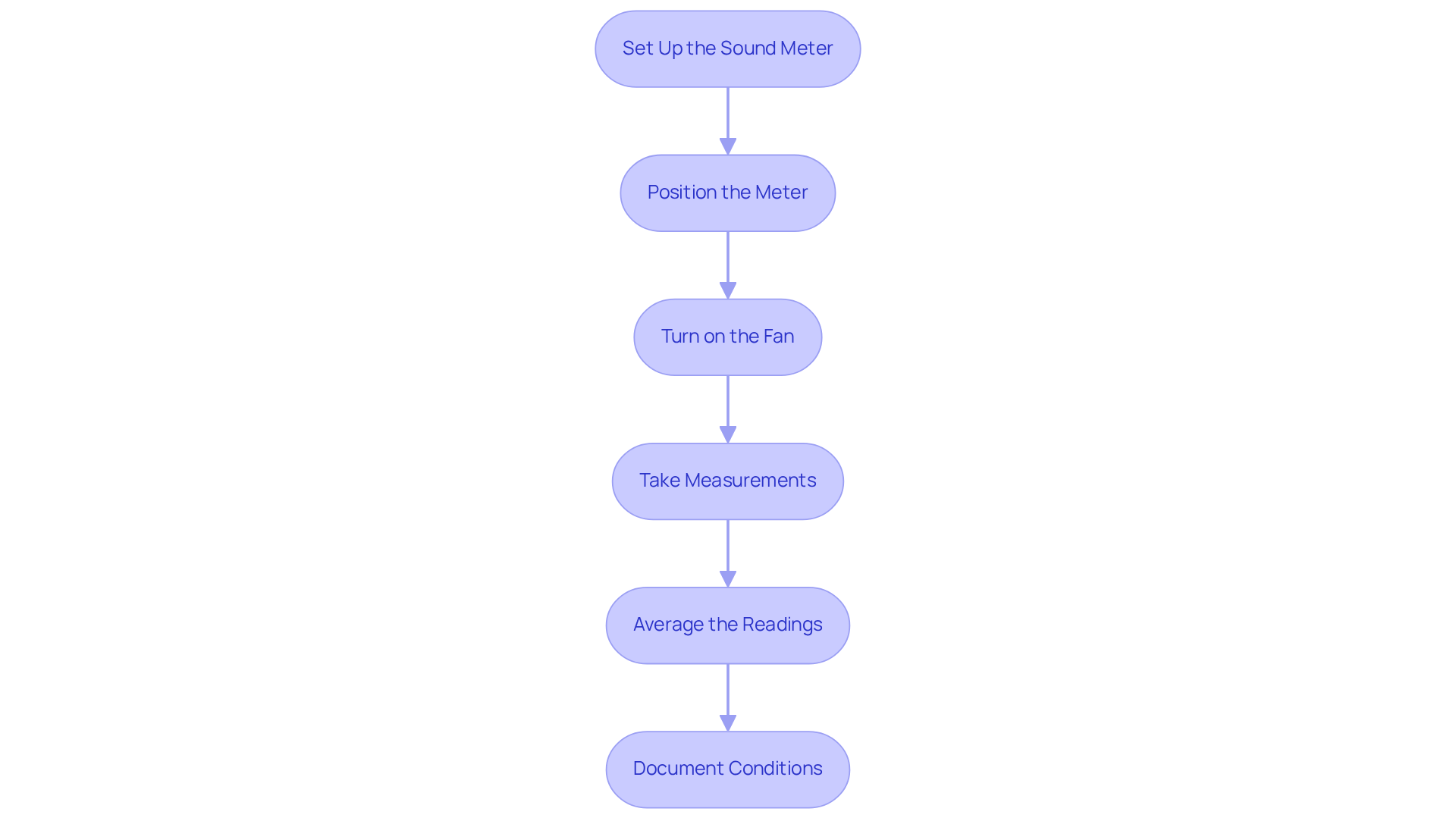
Troubleshoot Common Measurement Challenges
When assessing how many decibels is a fan, various challenges may arise. Effective strategies can help troubleshoot these common issues:
-
Inconsistent Readings: Variability in results often stems from improper calibration or positioning of the sound level meter. Ensure that the device is calibrated according to manufacturer specifications and positioned at an appropriate distance from the fan. Environmental factors, such as nearby machinery or traffic, can skew results. To mitigate this, conduct assessments in a controlled environment where ambient sound is minimized. Research indicates that nearly 22 million employees encounter potentially harmful noise in the workplace annually, highlighting the importance of accurate evaluations in preventing work-related noise-induced hearing loss.
-
Meter Malfunction: If the sound level meter fails to power on or produces erratic readings, first check the battery status. A low battery can lead to inaccurate readings. Additionally, confirm that the meter is calibrated correctly. Routine calibration checks are essential, as even minor variations can significantly impact precision. As noted by acoustics professionals, “Systematic error can be eliminated to a sufficient degree, whereas random error cannot.”
-
Background Disruption: Background noise can interfere with accurate readings. To minimize this disruption, select times for assessment when background sounds are at their quietest, such as early mornings or late evenings. Employing soundproofing materials around the measurement area can further reduce external noise, allowing for clearer readings. According to the NIOSH, effective hearing conservation programs require employers to assess sound intensities and provide training to reduce exposure.
-
Fluctuations in fan speed can lead to inconsistent sound intensity readings, raising the question of how many decibels is a fan. To ensure accurate measurements, utilize a tachometer to monitor and maintain a consistent fan speed during the testing phase. This consistency is crucial for obtaining reliable data that reflects the fan’s true performance.
These strategies can effectively address the common challenges faced by engineers. By implementing these troubleshooting techniques, you can enhance the reliability of your sound level measurements and ensure accurate assessments of how many decibels is a fan.
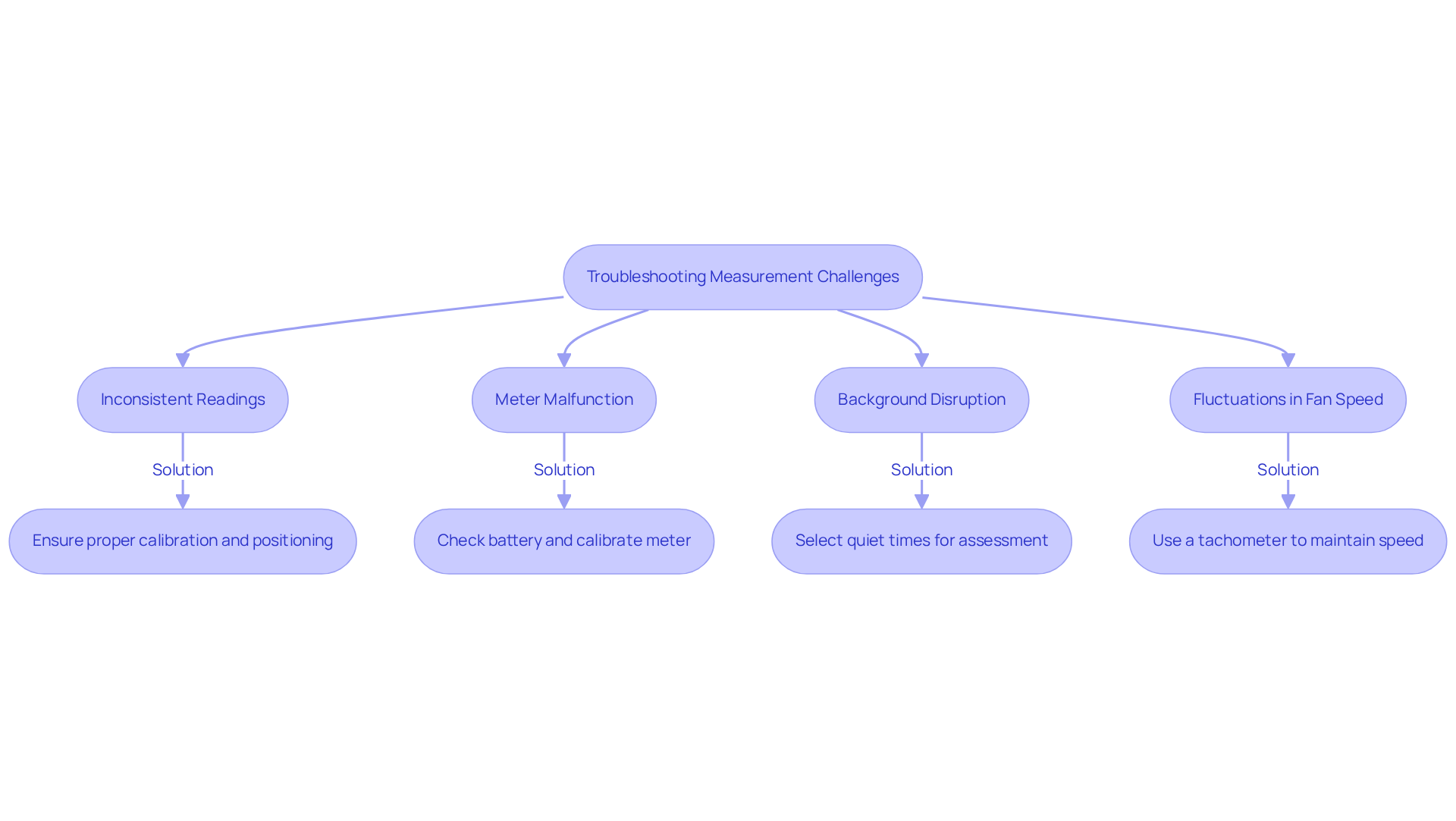
Conclusion
Understanding how to measure the decibel levels produced by a fan is essential for ensuring both safety and comfort. This guide has delineated the fundamental principles of decibel measurement, the necessary tools for precise readings, and step-by-step procedures to guarantee reliable results. By comprehending the significance of sound intensity and its implications for health, individuals can make informed decisions regarding fan selection and usage.
Key insights from the article underscore the importance of:
- Proper calibration
- Consistent measurement techniques
- Consideration of environmental factors
Utilizing a sound level meter, in conjunction with adherence to recommended procedures, facilitates the capture of accurate data on fan noise levels. Moreover, troubleshooting common challenges such as inconsistent readings and background noise ensures that assessments are both effective and precise.
Ultimately, measuring fan noise levels transcends a mere technical task; it constitutes a vital component in fostering healthier and more comfortable environments. By implementing the techniques discussed, individuals can proactively manage sound levels, safeguard hearing, and enhance overall quality of life. Whether for personal use or workplace safety, understanding how to measure decibels effectively empowers individuals to make choices that align with their noise tolerance and health standards.
Frequently Asked Questions
What is the significance of decibel measurement in understanding fan noise levels?
Decibel measurement is crucial for quantifying sound intensity, with each 10 dB increase representing a tenfold rise in sound pressure level.
What are some common decibel levels for everyday sounds?
Normal conversation typically registers around 60 dB, while a whisper is approximately 30 dB.
How does fan noise vary?
Fan noise can fluctuate based on factors such as speed, design, and environmental conditions, with household fans producing sound levels ranging from 30 dB for quieter models to over 60 dB for high-speed settings.
What is the relationship between power ratings and sound output in fans?
At 2 watts, the output of a fan can reach 89 dB, indicating that higher power ratings can correspond to increased sound output.
Why is it important to measure fan noise under consistent circumstances?
Consistent measurement conditions are essential for achieving accurate results in sound intensity assessments.
How does distance affect sound pressure level (SPL)?
Sound pressure level diminishes by -6 dB when the distance from the sound source doubles, which is important for evaluating fan sound in different applications.

